MARK BANDO'S WEBSITE
http://www.pathfindertour.com/BandoNormandyTours.html
MALARK
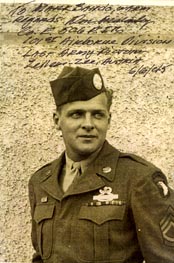
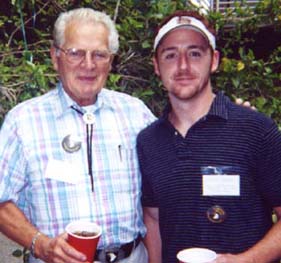 This photo shows the real Don Malarkey as a Tech Sgt in 1945. The actor who portrayed Don in the miniseries did an outstanding job, and emerged as one of the most memorable characters in the series.
This photo shows the real Don Malarkey as a Tech Sgt in 1945. The actor who portrayed Don in the miniseries did an outstanding job, and emerged as one of the most memorable characters in the series.
Don has been following my reviews of the BoB series (he is not on the Internet, but has friends who are, who supply him with hard copies from the BoB pages of this site), and has phoned and written me with his comments. The debate over WHO used brass knuckles at the Brecourt Battle rages on. Different recollections have resulted in conflicting testimony;the truth may never be known for certain.
The photo at upper right shows actor Scott Grimes, who did a splendid job of portraying Don in the miniseries, posing beside the real Malarkey at a recent E/506th reunion. c/o Bob Talbert
Various Cast Members from the HBO Series
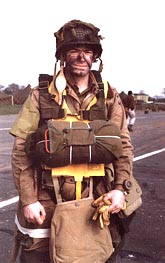
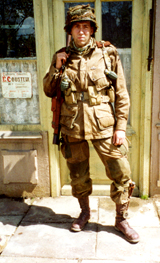 Above left is a pre D-Day airfield shot of the actor portraying Captain Lewis Nixon (Ron Livingston). Above right is a shot of
actor Ben Caplan, portraying Walter Gordon, posed in a reconstructed Norman village.
"SMOKEY"
Above left is a pre D-Day airfield shot of the actor portraying Captain Lewis Nixon (Ron Livingston). Above right is a shot of
actor Ben Caplan, portraying Walter Gordon, posed in a reconstructed Norman village.
"SMOKEY"
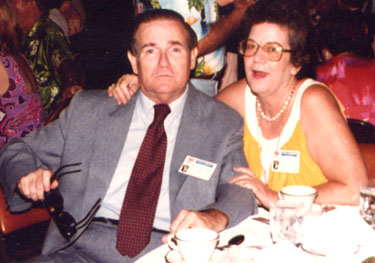 Walter S."Smokey"Gordon
was an original member of Easy Company and fought all the battles until seriously wounded at Bastogne. His wound was so serious that he barely escaped death and was not able to rejoin the company. When I met Walter at the 1976 Reunion in NYC, he was in 'Oil Properties'in LA.
Walter S."Smokey"Gordon
was an original member of Easy Company and fought all the battles until seriously wounded at Bastogne. His wound was so serious that he barely escaped death and was not able to rejoin the company. When I met Walter at the 1976 Reunion in NYC, he was in 'Oil Properties'in LA.
He wrote me a letter dated Aug 16, 1976, in which he said "It was a pleasure to talk to you and perhaps you can one day do a documentary on Company "E" 506 Parachute Infantry Regiment". At that time, I had already been working 6 years on a history of F/501-a history which has not been published to this day. Even my own publisher won't do it, because "A company history is too narrow in scope-nobody will buy it". Oh yeah? Of course, it also helps if your name is Stephen Ambrose. 1942 photo courtesy Bob Talbert
The Walter Gordon character in the miniseries had relatively little dialogue and this was evident to me and probably to his family as well. I didn't know Gordon in the 1940's, but I did know him in the 70's. I recall him as a large man, with an extroverted but pleasant personality and a very definite 'physical presence'. If I remember correctly, his WW2 buddies used to call him 'Senator Claghorn' or something to that effect, at the reunions. He was a boisterous and funny man, projecting the demeanor of a stereotyped southern politician. While I interviewed him, he made funny facial expressions with his mouth between answers. All the while, I believe he was aware he was entertaining you; he was definitely a character! We hit it off just fine and it's so hard for me to believe that he is gone now. Walter Gordon passed away on 19 April, 1997. I guess with such a large cast of characters, there was no way to individually develop many of them in the film.
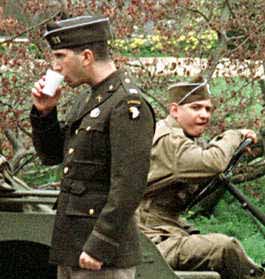 Above somewhere on the set in England, David Schwimmer takes a break-the popular American TV actor portrayed Captain Herb Sobel in the miniseries.
Above somewhere on the set in England, David Schwimmer takes a break-the popular American TV actor portrayed Captain Herb Sobel in the miniseries.
Liberation of Eindhoven
 An actual shot of one of the 2- 88mm dual purpose guns captured in Eindhoven on 18 September, 1944. The kill rings on the barrel of the weapon represent Allied planes or vehicles destroyed by the gun and its crew. c/o Reeder, HQ/506th.
An actual shot of one of the 2- 88mm dual purpose guns captured in Eindhoven on 18 September, 1944. The kill rings on the barrel of the weapon represent Allied planes or vehicles destroyed by the gun and its crew. c/o Reeder, HQ/506th.
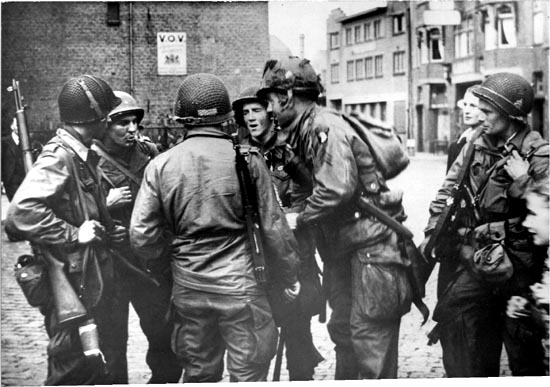 This shows a group of Easy company soldiers in Eindhoven, Holland on 18 September, 1944. Although the photo comes from the Don Pratt Museum collection at Ft Campbell, it was most likely taken by a Dutch civilian. Included in the group are Amos Taylor, McLaurin(?), Jim Alley, Bill Kiehn (KIA in Alsace), and Campbell T. Smith. The noncom with his back to the camera has been identified as (then) Sgt Carwood Lipton. Per Steph Leenhouwers, Dutch Airborne friend in Eindhoven, the photo was taken in the Hertogstraat.
This shows a group of Easy company soldiers in Eindhoven, Holland on 18 September, 1944. Although the photo comes from the Don Pratt Museum collection at Ft Campbell, it was most likely taken by a Dutch civilian. Included in the group are Amos Taylor, McLaurin(?), Jim Alley, Bill Kiehn (KIA in Alsace), and Campbell T. Smith. The noncom with his back to the camera has been identified as (then) Sgt Carwood Lipton. Per Steph Leenhouwers, Dutch Airborne friend in Eindhoven, the photo was taken in the Hertogstraat.
MARK BANDO'S WEBSITE
"They Got Us Surrounded, the Poor Bastards!"
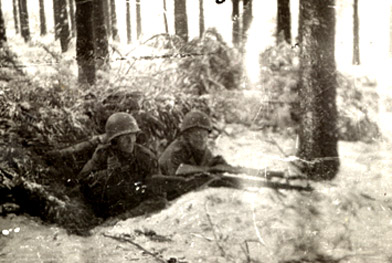 Such was the battle cry as the 101st made it's historic stand at Bastogne. But to the men doing the fighting, it was a grim, miserable period. As John Tocco of the 326th AEB put it: "You lived like an animal, in a frozen hole in the ground. You started to think and react like an animal-you couldn't help it."
Such was the battle cry as the 101st made it's historic stand at Bastogne. But to the men doing the fighting, it was a grim, miserable period. As John Tocco of the 326th AEB put it: "You lived like an animal, in a frozen hole in the ground. You started to think and react like an animal-you couldn't help it."
After leaving Bastogne, James K. Howell of I/502 found himself on outpost duty in Alsace-Lorrane. At that time he observed: "It was during this duty that I realized how much of an animal I had turned into. My senses and instincts were very acute. I could actually hear and analyze small rodents running through the grass. When a bird or birds fluttered in the bushes and trees, I could determine if it was normal or if some unusual action had caused this movement. It occurred to me that, no doubt this was why I was still alive."
The photo above shows 2 riflemen of 1st Bn 506th, in the woods between Luzery-Foy and was taken by Lt Bill Kennedy.
So adversive were the weather conditions, that few decent foxhole photos were
taken at Bastogne.
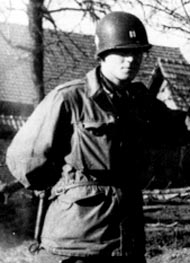 This photo was taken by divisional photographer Al Krochka around the beginning of February, 1945 at Hochstett, near Hagenau, in Alsace-Loraine. The subject of the photo, wearing M43s, is Richard D. Winters; note that he still wears captain's rank on his helmet. One mystery not explained in Ambrose's book, is what happened to LTC Strayer after Holland. Was Winters EXO of 2/506th at Bastogne? Who really commanded the 2d Bn at that time? Winters was doing the job of a major while still a captain.
This photo was taken by divisional photographer Al Krochka around the beginning of February, 1945 at Hochstett, near Hagenau, in Alsace-Loraine. The subject of the photo, wearing M43s, is Richard D. Winters; note that he still wears captain's rank on his helmet. One mystery not explained in Ambrose's book, is what happened to LTC Strayer after Holland. Was Winters EXO of 2/506th at Bastogne? Who really commanded the 2d Bn at that time? Winters was doing the job of a major while still a captain.
SAVING SGT NILAND
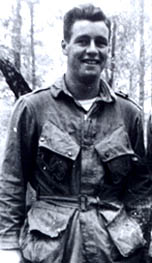 Frederick'Fritz'Niland of Tonawanda, NY was a Sgt in H/501 PIR. He was misdropped below Carentan on D-Day, but fought his way back to the 501 with his buddy Jack Breier. The 1943 photo above was made with Breier's camera. Although virtually every writer who tells the Niland family story manages to gaff-up the details, the basic facts are these; all three of Fritz's brothers, who were on active duty with the U.S. military, became casualties in less than three weeks. Oldest brother Eddie was
on an Air Corps bomber, which was shot down in the C.B.I. on 16 May, 1944. His mother, Augusta, received the MIA telegram about Eddie on 8 June, 1944. Her other three sons were all participating in the Normandy invasion with the Army.
Frederick'Fritz'Niland of Tonawanda, NY was a Sgt in H/501 PIR. He was misdropped below Carentan on D-Day, but fought his way back to the 501 with his buddy Jack Breier. The 1943 photo above was made with Breier's camera. Although virtually every writer who tells the Niland family story manages to gaff-up the details, the basic facts are these; all three of Fritz's brothers, who were on active duty with the U.S. military, became casualties in less than three weeks. Oldest brother Eddie was
on an Air Corps bomber, which was shot down in the C.B.I. on 16 May, 1944. His mother, Augusta, received the MIA telegram about Eddie on 8 June, 1944. Her other three sons were all participating in the Normandy invasion with the Army.
Robert, a.k.a. "Bob The Beast" Niland jumped near St Mere Eglise with D/505PIR, 82nd Airborne. Bob was killed in heavy fighting at Neuville au Plain on June 6th. Brother Preston was a lieutenant in the 22nd Infantry Regiment, 4th Division, and landed on Utah Beach. On 7 June, 1944, he was also killed in the area NW of Utah Beach. When Fritz returned from his misdrop circa 11 June, he rejoined H/501 and was decorated for grenading a German m.g nest at Hill 30 on 12 June. After learning that Fritz was probably the sole surviving son in his family, Fr. Francis Sampson, Catholic Chaplain of the 501, started paperwork to have Fritz sent back to safer duty in the U.S. The paperwork took quite a while to go through, and didn't come back approved until the end of the summer.
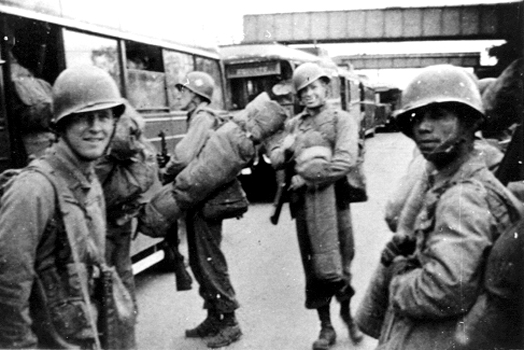 Fritz was NOT pulled out of the front lines, as Ambrose asserts in his books. Fritz remained in Normandy with the 501 until they sailed back to England on an LST. The photo above was taken by Fritz's best buddy, Jack Breier in Southhampton, England in July, 1944. The troops had just debarked the LST and were loading on buses to ride back to their base camp at Lamborne, England. Cate, Fritz's daughter has verified that the trooper standing at left in the photo is Fritz Niland.
Fritz was NOT pulled out of the front lines, as Ambrose asserts in his books. Fritz remained in Normandy with the 501 until they sailed back to England on an LST. The photo above was taken by Fritz's best buddy, Jack Breier in Southhampton, England in July, 1944. The troops had just debarked the LST and were loading on buses to ride back to their base camp at Lamborne, England. Cate, Fritz's daughter has verified that the trooper standing at left in the photo is Fritz Niland.
Fritz remained with H/501 through the summer of 1944, suiting-up for two missions which were canceled, before the orders came through for him to return to the Zone of Interior. Fritz protested the order-he wanted to return to battle and avenge his lost brothers. Against his objections, he was overruled and sent back for M.P. duty in N.Y. state until the war ended.
One of his brothers did survive-Eddie returned from his MIA status many months later, having been in a Japanese P.O.W. camp. Mrs Niland did NOT receive three telegrams in one day regarding the loss of her sons,(I still can't figure out where Ambrose conjured-up THAT particular fiction-it was good Hollywood stuff for the movie though.) Also two, not three of Fritz's brothers were in fact killed in action. The story of the Nilands wound-up in two of Ambrose's books, and Hollywood screenwriters used the basic scenario of a 101st paratrooper who had lost three brothers as the starting premise for the screenplay of 'Saving Private Ryan'.
The connection to Easy Company was that Warren 'Skip' Muck knew the Nilands from their mutual hometown of Tonawanda, N.Y. Before D-Day, Skip, Don Malarkey, Joe Toye, and Chuck Grant, met Bob and Fritz in London. Bob Niland had already experienced battle with the 82nd Airborne and gave his eager audience some views on the realities of combat.
After returning home from WW2, Fritz Niland did not "cure some disease, or invent a longer lasting lightbulb"-instead, he became an oral surgeon and innovated new techniques in that field, which is more than the average man will ever do. According to Cate, Fritz was a compassionate man, who hated to see people in pain. That drove him to pursue dental work, as a means of helping aleviate much suffering. Fritz Niland passed away in the early 1980's but his daughters Cate and Mary are active in attending WW2 functions and Airborne reunions. photo above courtesy Jack Breier.
The Niland family story as told in Ambrose's book 'Band of Brothers', was based on testimony from Don Malarkey as well as Father Francis Sampson's factually skewed writing. (There is a detailed discussion of this in the last chapter of my current book). Living way out in little Astoria Oregon, Don had no contact with the Nilands after the war, so could not learn the details about Eddie surviving the war, etc. It's too bad Ambrose didn't contact the Niland family (a number of them are easily found in the Buffalo, NY area), as they could have set him straight on the details of their family history.
The Niland family was not mentioned in the BoB miniseries.
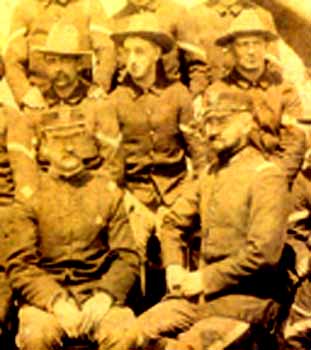 Fritz's dad, Mike "The Bull" Niland, served in the Spanish-American War, with the Rough Riders. Mike is pictured at top right above, sitting with Teddy Roosevelt(lower left), at San Juan Hill, almost half a century before D-Day. photo c/o Cate Niland.
Fritz's dad, Mike "The Bull" Niland, served in the Spanish-American War, with the Rough Riders. Mike is pictured at top right above, sitting with Teddy Roosevelt(lower left), at San Juan Hill, almost half a century before D-Day. photo c/o Cate Niland.
Stephen Ambrose in Perspective
As with many high profile figures, Professor Ambrose has been the subject of various controversies, even before the Plagiarism furor arose early in 2002. Those of you who have frequented this website since its inception know that much pro and con about his work have been aired here, and any shortcomings have been frankly discussed. Now that he has succumbed to lung cancer, we will remember the huge part he played in bringing WW2 back into the consciousness of the American public. As many lesser-known historians continue with their individual projects, the
writing and research void left by Ambrose's passing WILL be filled. However it is unlikely that any individual history writer will receive the mass acclaim, sales, or accompanying wealth that Ambrose enjoyed. The Media and the publishing world touted him as an Icon, in a way that no other pop historian in our society has ever been.
Yes, many of us had issues with S.A., and I likened his mega success to the way Blockbuster Video puts many small, privately-owned video stores out of business. Many dedicated but obscure historians have continued their valuable research year in, year out, through the decades, only to have their work ignored by the mass public audience. Largely due to Ambrose's virtual monopoly on book sales in the popular history market,
many lesser-known writers have not had a chance. This certainly has much to do with the resentment that many individuals have felt toward his huge success.
With great fame and repute comes great responsibility to convey the story as accurately as possible to the reading audience. Each individual military unit that Ambrose wrote about has complained about various inaccuracies in what he stated about them. Despite pleas to correct those mis-statements, Ambrose demonstrated a lack of willingness to make those errors right in subsequent editions of his work. As historians, we understand that all of us make mistakes, but this refusal to admit and correct errors also did little to endear Ambrose to many veterans or history writers. There was also a feeling that someone as big as he was in reputation, should never have made some of the more blatant errors he made. There was also, a perception that, with a team of knowledgable proofreaders, some of the more glaring mistakes would never have gotten into print in the first place.
Although Tom Hanks may have overstated the case by hailing Ambrose as 'The Greatest Historian of the 20th Century", somebody else recently wrote that Ambrose did more to educate the American public on WW2 than any author in the 20th Century. Whatever else can be said about him, that statement is certainly true. His books, along with Brokaw's and the film 'Saving Private Ryan', have done more than anything else to create the current wave of public interest in WW2. Those of us who carried the torch of WW2 research through decades of public indifference are at least indebted to all the above-named people and projects, for creating the current Renaissance of public interest in WW2.
webmaster's note: Bob Talbert, Don Malarkey, Tracy Gordon Goff (daughter of the late Smokey Gordon), as well as historian Jake Powers have made valuable contributions to the Band of Brothers pages of Trigger Time and their generosity has benefitted all visitors to these pages. Thanks again to all of you. MB

















